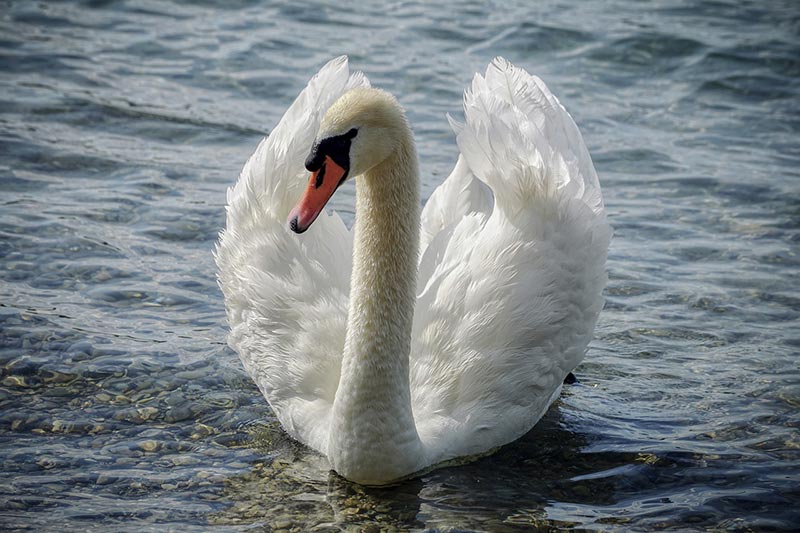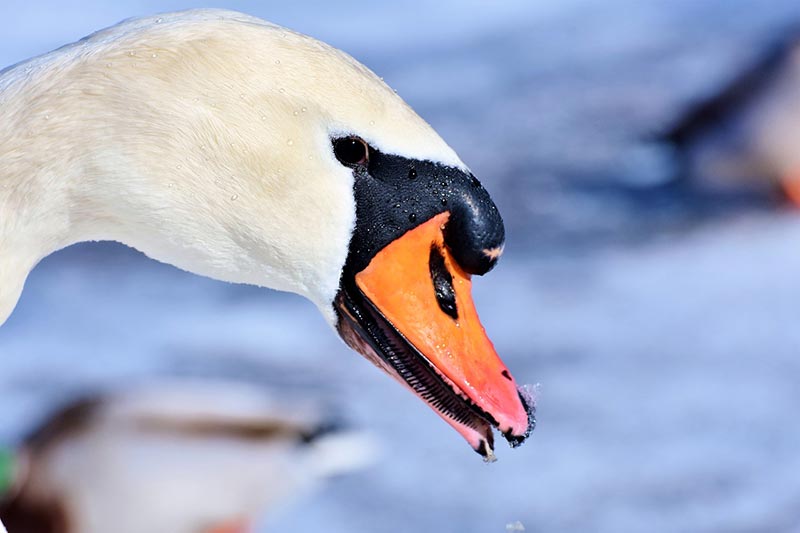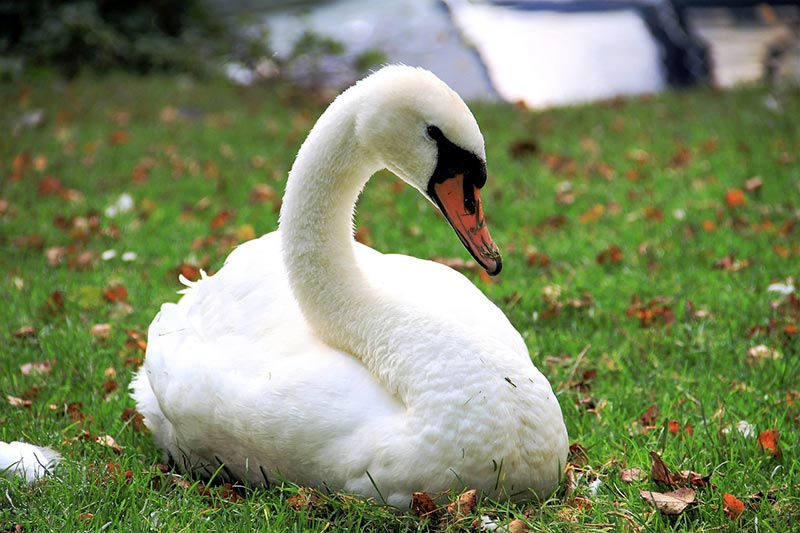Do Swans Have Teeth? Anatomy, Facts, & FAQ
Last Updated on

Swans are majestic birds that represent beauty, elegance, and romance. Something about their appearance draws people in, and many of us wonder about their lifestyle and habits. When we think about swans, an array of questions comes to mind, and one of the questions that’s quite common is whether swans have teeth or not.
Although it might seem like some birds have teeth, the truth is birds don’t have teeth¹, which also applies to swans. While you can see teeth-like serrated edges inside a swan’s beak, those are not actual teeth.
These teeth-like edges help swans to catch aquatic creatures and hold on to algae. Throughout the article, we’ll provide more details about the so-called “swan teeth,” so keep reading to learn more.

What Does a Swan Bill Look Like?
Swans have large, strong bills that help them peck, catch, pull, and swallow food. Their bills are long, flattened, and have specially designed sections and properties that help these birds feed. One section of their bills that makes us believe swans have teeth is called the lamellae.

Swan Bill Parts
Swan bills consist of a basal knob, nares, lower and upper mandibles, a keratinized layer, lamellae, and a nail.
- Spatulate-shaped bill
- Lamellae
- Nail
Spatulate-shaped bill
The spatulate shape of swan bills, which is flat and elongated, helps swans crush their food. Still, their bills don’t have enough sharpness and strength to crush food that’s too hard, but they can break down the majority of the food they consume.
Lamellae
While the lamellae have almost the same function as teeth, their structure is quite different. The most significant difference between actual teeth and lamellae is that lamellae lack enamel, the protective layer covering the teeth of mammals and humans.
Although lamellae may seem like separate structures inside the bill, they are made from the bill itself. They are invisible when a swan holds its bill closed unless there’s a deformity that could expose the lamellae.
They consist of cartilage, a firm, flexible tissue that makes the “swan teeth” sharp. Because of that, lamellae can cut through vegetables and pierce the flesh of small animals swans eat. When swans feed in the water, they often catch water and mud along with their prey, and lamellae also help to filter out the water and soil.

Nail
Another bill part that helps swans when hunting for food is the nail. It’s a small bump that allows swans to easily dig through mud or dirt when in search of seeds, worms, and other foods.

Are There Teeth on Swan Tongues?
This is another question that comes to many people’s minds, and that’s because swans also have lamellae on their tongues. Again, like other birds, swans don’t have teeth, but you can notice the so-called teeth on both their bill edges and their tongues.
Lamellae on their tongues allow them to pull out plants from the ground. When swans want to pull out a plant, they will hold it with their bill, gripping it with the lamellae on their tongues. Once they get a good grip, swans will move their heads up, pulling the plant out.
Although lamellae are not actual teeth, they also aid in holding prey such as insects and rats.
Would a Swan Bite Hurt a Human?
Swans are commonly calm animals, but they can occasionally have a temper, especially if it’s breeding season or they’re defending their eggs or young ones. Such situations may cause swans to act aggressively, although they’re typically not aggressive to humans.
That doesn’t mean you should try to mess with their nests, as a possibility of a swan bite is still there. Because they’re protective of their young ones, they might flap their wings at you, hiss, and there’s a chance they might try to bite you if you approach too close to the nest.
Sometimes, you could also trigger an attack when trying to feed swans. However, this is not as common as they typically love to get food from humans.

Can You Feed Swans Safely?
You can safely feed swans as they are commonly loved by humans who offer them food. It’s especially beneficial to feed swans when the weather gets cold as it might be hard for them to find food in their environment.
They usually feed on aquatic plants, fish, insects, and other small animals, so there’s an array of foods you can offer them.
- Spinach
- Cabbage
- Lettuce
- Corn
- Wheat
- Mushrooms
- Avocados
- Tomatoes
- Eggplants
- Apples
- Chocolate
- Popcorn
- Onions

How To Feed Swans
Before feeding swans, you should know some pointers that will allow the feeding process to flow easily.
- Always throw the food directly into the water, and avoid throwing it on the ground. If you throw the food on the ground, you’ll encourage the swans to leave the water the next time they notice humans, which can make them susceptible to predators.
- Swans can’t chew their food, so you should offer them small-sized bites they can easily digest.
- Avoid feeding the swans if you already see other people feeding them, as the food might go to waste.
- Don’t try to pet, chase or catch swans as they could become aggressive.
- Verify that your state doesn’t have any legal restrictions on feeding swans.

Conclusion
Swans have teeth-like lamellae, and although they’re not actual teeth, they’re very helpful when swans are sourcing for food. These structures exist on their bills and tongues, representing the bill structure that allows swans to hold their prey and catch plants and small animals.
Featured Image Credit: suju-foto, Pixabay
About the Author Visnja Radosavljevic
Visnja is a creative, adaptable content writer that covers various topics such as DIY, pets, home improvement, travel, gardening, and more. As a young mom and a college student, she didn’t have enough time to balance her personal and work life, so after multiple years of working a regular 9 to 5 job, she decided to pursue her passion and make a living out of it. She has been writing for a couple of years now, helping people to find valuable and interesting information online.
Related Articles:
10 Types of Hummingbirds in Arkansas (With Pictures)
8 Types of Hummingbirds in Nebraska (With Pictures)
5 Types of Hummingbirds in Idaho (With Pictures)
3 Types of Hummingbirds in Mississippi (With Pictures)
8 Types of Hummingbirds in Kansas (With Pictures)
5 Types of Hummingbirds in West Virginia (With Pictures)
5 Types of Hummingbirds in Ohio (With Pictures)
Where Do Nuthatches Nest? Nuthatch Nesting Habits Explained
